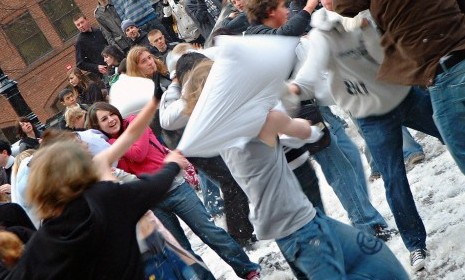Evolution of the flash mob
Since the appearance of the first flash mob, in 2003, the "inexplicable" gatherings have taken a violent turn. Here, a look at how flash mobs have changed

Flash mobs — quick, seemingly spontaneous mass gatherings of strangers, often organized through e-mail, social networks, and text messages — have taken many forms over the years. The first flash mob, held in New York City on June 3, 2003, and orchestrated by Harper's magazine senior editor Bill Wasik, reportedly involved a relatively small crowd of participants, who gathered at Macy's department store to admire a rug. Since then, flash mobs have taken place around the world, and expanded to include thousands of people doing everything from choreographed dances to simply standing still. But recently, teenagers in Philadelphia have used the flash mob technique to wreak havoc on the city, sparking fear in citizens and a crackdown by the police. Here's a look at how flash mobs have evolved:
1. Small beginnings
Inspired by Wasik's first flash mob, Caroline Martin organized this small flash mob in August 2003 at the Otakon Japanese animation festival in Baltimore. "I posted about it in the Otakon community [website] and printed out flyers and then crossed my fingers, hoped people would show up," says Martin on her Vimeo post. "And they did!"
The Week
Escape your echo chamber. Get the facts behind the news, plus analysis from multiple perspectives.

Sign up for The Week's Free Newsletters
From our morning news briefing to a weekly Good News Newsletter, get the best of The Week delivered directly to your inbox.
From our morning news briefing to a weekly Good News Newsletter, get the best of The Week delivered directly to your inbox.
2. Corporate takeover
By early 2009, flash mobs had spread around the globe, which piqued the interest of the corporate world. And on Jan. 15, 2009, T-Mobile staged their own version of the flash mob at London's Liverpool Street train station — an extremely popular flash mob location. This time, passersby were treated to a highly choreographed dance medley, performed by 400 strangers, including tourists and Underground staff. Video of the event later ran as an advertisement and garnered more than 18 million views on YouTube.
3. Having a bash
A month after the T-Mobile mob stunt, cushion-toting flash mob participants gathered at a San Francisco park on Valentine's Day 2009 for the annual mass pillow fight. The feathery mess caused by the pillow fight caused more than $20,000 in damages, prompting a crackdown on the gatherings by city authorities.
A free daily email with the biggest news stories of the day – and the best features from TheWeek.com
4. Go on, "Beat It"
Following the death of Michael Jackson on June 25, 2009, many organizers arranged flash mob tributes to the late King of Pop. In July, 2009, Swedish dance group BouncE organized this flash mob at Sergelstorg and Central Station in Stockholm, which included more than 300 dancers busting moves to Jackson's "Beat It."
5. Flash mobs go bad
After a massive snowball fight in downtown Philadelphia, more than 100 teenagers stormed into Macy's department store in February, and began pushing customers and wrecking merchandise. Since then, the city's teens have organized "aggressive and raucous" flash mobs that are "part bullying, part running of the bulls," says Ian Urbina in The New York Times. The uncontrollable bands of teens have caused the city to impose a curfew for adolescents.
-
 Quiz of The Week: 6 – 12 December
Quiz of The Week: 6 – 12 DecemberQuiz Have you been paying attention to The Week’s news?
-
 The week’s best photos
The week’s best photosIn Pictures A man's best friend, the elephants in the room, and more
-
 A TikTok trend has Gen Z men leaving streetwear behind for more preppy attire
A TikTok trend has Gen Z men leaving streetwear behind for more preppy attireThe Explainer More than a zipper: Young Black men embrace the ‘quarter-zip movement‘